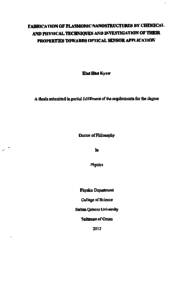Document
Fabrication of plasmonic nanostructures by chemical and physical techniques and investigation of their properties towards optical sensor application
Publisher
Sultan Qaboos University
Gregorian
2017
Language
English
English abstract
Plasmonics is the study of optical phenomenon of noble metal nanostructures that interact with electromagnetic light to create surface plasmon resonance on their surface. Metallic nanostructures can be directly grown on the substrate by physical technique or colloidal metallic NPs immobilized on the substrate by chemical method. Self-organization of monolayer gold nanoparticles (AuNPs) on 3 aminopropyltriethoxysilane (APTES) functionalized glass substrate is reported. The orientation of APTES molecules on glass substrates plays an important role in the interaction between AuNPs and APTES molecules on the glass substrates. The as grown monolayers were annealed in ultrahigh vacuum and air at 600 °C and studied the surface and interface properties. The second part of this work was to employ the direct deposition of metallic NPs on the glass substrate by physical approach. DC magnetron sputtering with inert gas condensation (IGC) technique at room temperature (RT ~ 25 °C) was used to fabricate AgNPs/AuNPs on glass substrates. The as fabricated substrates were treated by post annealing below and above the glass transition temperature at 500 °C and 600 °C and studied the surface and bulk properties. In the third part of this study, silver nanoparticles (AgNPs) were deposited on soda lime glass substrates by DC magnetron sputtering with inert gas condensation (IGC) technique during in-situ annealing in an inert gas environment. The influence of in-situ annealing temperature on the surface morphology, surface composition and chemical states were investigated. Antibacterial activity of AgNPs against Escherichia coli and Bacillus cereus was also examined. For the fourth part, the exchange role of gold (Au) and silver (Ag) in bimetallic films co-evaporated onto soda-lime glass substrates with Au-Ag volume ratios of 1:2, 1:1 and 2:1 have been demonstrated. Annealing of the films above the glass transition temperature in air led to non-alloying nature of the films, silver neutrals (Ag9 and gold nanoparticles (AuNPs) on the surface, along with silver nanoparticles (AgNPs) inside the glass matrix. The higher the Au content in the film is, the more likely Ago to stay on the surface and impacts on the size distribution of AuNPs and consequently on the refractive index sensitivity measurements. The effect of substrate nature (compositions and material properties) on the formation of monometallic gold (Au), silver (Ag) and bimetallic gold-silver nanoparticles (Au-Ag NPs) by thermal annealing was carried out. Monometallic Au, Ag and bimetallic Au-Ag thin film with volume ratio of (1:1) was selected to deposit on quartz substrate by electron beam evaporation technique. Upon annealing the as prepared samples at 600 °C, monometallic AuNPs and formation of Au-Ag alloy NPs with homogeneous spherical shapes were obtained. However, monometallic Ag films could not endure at 600 °C and any AgNPs formation on the surface was not observed. The bulk refractive index sensitivity performance was studied by using alloy NPs on quartz substrate and the best LSPR performance of 61 nm/RIU was achieved.
Description
Thesis
Member of
Resource URL
Arabic abstract
الخلاصة البلازمون السطحي هي دراسة الظاهرة البصرية لأسطح المعادن النبيلة التي تتفاعل مع الأمواج الكهرومغناطيسية لخلق رنين بلازموني على سطحها. التراكيب القانونية للجسيمات المعدنية يمكن انشائها على حوامل بطرق فيزيائية وكيميائية. لهذا فقد تم دراسة ارتباط جسيمات الذهب الدقيقة على سطح تمت معالجته بالمادة العضوية ( 3- أمينوبروبيل تراي توکسایلزيلين). تعلب اتجاه نقاط الارتكاز للمادة العضوية دورا مهما في التفاعل بين جسيمات الذهب والمادة العضوية على السطح الزجاجي المعالج بحيث يؤثر اتجاه الارتكاز على مدى التنظيم الذاتي وتوزيعها على السطح الزجاجي المعالج. تم تسخين الطبقات الأحادية بالفراغ لغاية 600 درجة سيليزية ومن ثم دراسة خصائصها السطحية. أما الجزء الثاني من هذه الدراسة فقد اهتم بالترسيب المباشر للجسيمات بالطريقة الفيزيائية. تم ترسيب جسيمات الذهب على زجاج الصودا لايم بنفس طريقة ترسيب جسيمات الفضة كما هو موثق بالدراسة باستخدام تقنية الغاز الخامل التكثيف بدرجة حرارة الغرفة وذلك لترسيب جسيمات الفضة على الذهب. ثم تمت معالجة سطح الزجاج بالتسخين بأعلى وأقل من درجة التحول (500 و 600 درجة سيليزية). وقد ركز الجزء الثالث من الدراسة على الترسيب المباشر لجسيمات المعادن الدقيقة على الزجاج بالطريقة الفيزيائية مع التسخين. تم ترسيب جسيمات الفضة الدقيقة على زجاج من نوع (صودا-لايم) بنفس الطريقة التي تم اتباعها لترسيب جسيمات الفضة كما هو موثق وذلك باستخدام تقنية الغاز الخامل للتكثيف. وعند دراسة أثر التسخين على ترسيب جسيمات الفضية وجد أن انتظام توزيع الجسيمات وتمت دراسة اثر التسخين على السطح من حيث الشكل والتركيب الكيميائي. أما فعالية العينة في تثبيط البكتيريا (القولونية وسيريوس العصوية) فقد كانت بالعينة التي تم تصنيعها عند درجة حرارة 500 درجة سيليزية. القسم الرابع أهتم بترسيب طبقتين من الذهب والفضة على سطح زجاج الصودا لايم وذلك بنسب مختلفة بين جسيمات (الذهب: الفضة) كالتالي 2 : 1 , 1 : 1 , 1 : 2 على الترتيب. تسخين العينات فوق درجة تحول الزجاج لم يؤدي الى تسبيك جسيمات الذهب مع الفضة بل عادلت جسيمات الفضة جسيمات الذهب على السطح وغمر بعض جسيمات الفضة تحت سطح الزجاج. وقد وجد أنه كلما زاد تركيز جسيمات الذهب كل ما أدى ذلك إلى بقاء جسيمات الفضة بشكل أكبر على السطح متأثرة بجحم جسيمات الذهب وحساسيتها لمعامل الانكسار النسبي. الجزء الأخير من هذه الدراسة ركز على دراسة أثر طبيعة السطح قبل الترسيب من حيث التركيب والخصائص على تكون الجسيمات على سطحة سواء أكنت احادية أم متنوعة الترسيب عند تسخينه. تم أختيار جسيمات الفضة والذهب المرسبة أحاديا بنسبة 1 : 1 ليتم ترسيبها على الكوارتز باستخدام تقنية التبخير بالاشعاع الالكتروني. كان أثر التسخين تكون طبقة أحادية من الذهب وطبقة من سبيكة الذهب والفضة وذلك بعد التسخين لدرجة حرارة 600 درجة سيليزية الا أنه لم يتم ملاحظة طبقة الفضة على السطح عند هذه الدرجة. وبقياس حساسية معامل الانكسار النسبي للسبيكة على الكوارتز تبين أنه أفضل رنين بلازموني للسطح بمقدار 61 نانومتر وحدة معامل الانكسار النسبي.
Category
Theses and Dissertations

